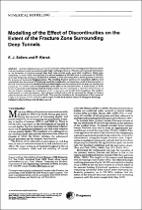 ResearchSpace
ResearchSpace
Modelling of the effect of discontinuities on the extent of the fracture zone surrounding deep tunnels
JavaScript is disabled for your browser. Some features of this site may not work without it.
- ResearchSpace
- →
- Research Publications/Outputs
- →
- Journal Articles
- →
- View Item
| dc.contributor.author |
Sellers, EJ

|
en_US |
| dc.contributor.author |
Klerck, P

|
en_US |
| dc.date.accessioned | 2007-02-06T08:54:56Z | en_US |
| dc.date.accessioned | 2007-06-07T10:02:27Z | |
| dc.date.available | 2007-02-06T08:54:56Z | en_US |
| dc.date.available | 2007-06-07T10:02:27Z | |
| dc.date.issued | 2000-10 | en_US |
| dc.identifier.citation | Sellers, EJ and Klerck, P. 2000. Modelling of the effect of discontinuities on the extent of the fracture zone surrounding deep tunnels. Tunnelling and Underground Space Technology, vol 15(4), pp 463-469 | en_US |
| dc.identifier.issn | 0886-7798 | en_US |
| dc.identifier.uri | http://hdl.handle.net/10204/1484 | en_US |
| dc.identifier.uri | http://hdl.handle.net/10204/1484 | |
| dc.description.abstract | A series of physical and numerical model tests were performed to investigate the behaviour of the rock surrounding circular excavations under high confining pressures. The aim was to provide information on the formation of fractures around deep level mine tunnels under controlled conditions. Solid cubes containing a circular hole were confined to a vertical pressure of 200 MPa with a confinement of 100 MPa in the two horizontal directions. To provide a contrast, a block was made from a series of plates to simulate the presence of horizontal bedding planes. The resulting fracture patterns are completely different and emphasized that the amount of fracturing would be considerably increased as a result of discontinuities in the rock. The tests confirmed that discontinuities in the rock mass can alter the fracture patterns associated with an excavation. The discontinuities induce more fracturing than is observed in the solid blocks. Thus, the extent of fracturing expected in deep level mining excavations will be greater than predicted from borehole breakout analyses. However analysis of acoustic emission data provides insights into the response of the rock during loading and unloading and assists with the identification of the effect of the discontinuities. A model based on Mohr Coulomb plasticity and rotating smeared-crack concepts has been developed to represent the formation of discrete fracture processes in a continuum under compressive and tensile stress conditions. The model is implemented in a discrete element - finite element method and is able to represent the change in fracture patterns between the solid and jointed blocks. This provides confidence for the application of the numerical model to the design of mine tunnels at great depth. | en_US |
| dc.format.extent | 795468 bytes | en_US |
| dc.format.mimetype | application/pdf | en_US |
| dc.language.iso | en | en_US |
| dc.publisher | Pergamon-Elsevier Science Ltd | en_US |
| dc.rights | Copyright: 2000 Pergamon-Elsevier Science Ltd | en_US |
| dc.subject | Mine tunnels | en_US |
| dc.subject | Rock fabrics | en_US |
| dc.subject | Underground tunnel fractures | en_US |
| dc.subject | Civil engineering | en_US |
| dc.title | Modelling of the effect of discontinuities on the extent of the fracture zone surrounding deep tunnels | en_US |
| dc.type | Article | en_US |
| dc.identifier.apacitation | Sellers, E., & Klerck, P. (2000). Modelling of the effect of discontinuities on the extent of the fracture zone surrounding deep tunnels. http://hdl.handle.net/10204/1484 | en_ZA |
| dc.identifier.chicagocitation | Sellers, EJ, and P Klerck "Modelling of the effect of discontinuities on the extent of the fracture zone surrounding deep tunnels." (2000) http://hdl.handle.net/10204/1484 | en_ZA |
| dc.identifier.vancouvercitation | Sellers E, Klerck P. Modelling of the effect of discontinuities on the extent of the fracture zone surrounding deep tunnels. 2000; http://hdl.handle.net/10204/1484. | en_ZA |
| dc.identifier.ris | TY - Article AU - Sellers, EJ AU - Klerck, P AB - A series of physical and numerical model tests were performed to investigate the behaviour of the rock surrounding circular excavations under high confining pressures. The aim was to provide information on the formation of fractures around deep level mine tunnels under controlled conditions. Solid cubes containing a circular hole were confined to a vertical pressure of 200 MPa with a confinement of 100 MPa in the two horizontal directions. To provide a contrast, a block was made from a series of plates to simulate the presence of horizontal bedding planes. The resulting fracture patterns are completely different and emphasized that the amount of fracturing would be considerably increased as a result of discontinuities in the rock. The tests confirmed that discontinuities in the rock mass can alter the fracture patterns associated with an excavation. The discontinuities induce more fracturing than is observed in the solid blocks. Thus, the extent of fracturing expected in deep level mining excavations will be greater than predicted from borehole breakout analyses. However analysis of acoustic emission data provides insights into the response of the rock during loading and unloading and assists with the identification of the effect of the discontinuities. A model based on Mohr Coulomb plasticity and rotating smeared-crack concepts has been developed to represent the formation of discrete fracture processes in a continuum under compressive and tensile stress conditions. The model is implemented in a discrete element - finite element method and is able to represent the change in fracture patterns between the solid and jointed blocks. This provides confidence for the application of the numerical model to the design of mine tunnels at great depth. DA - 2000-10 DB - ResearchSpace DP - CSIR KW - Mine tunnels KW - Rock fabrics KW - Underground tunnel fractures KW - Civil engineering LK - https://researchspace.csir.co.za PY - 2000 SM - 0886-7798 T1 - Modelling of the effect of discontinuities on the extent of the fracture zone surrounding deep tunnels TI - Modelling of the effect of discontinuities on the extent of the fracture zone surrounding deep tunnels UR - http://hdl.handle.net/10204/1484 ER - | en_ZA |





